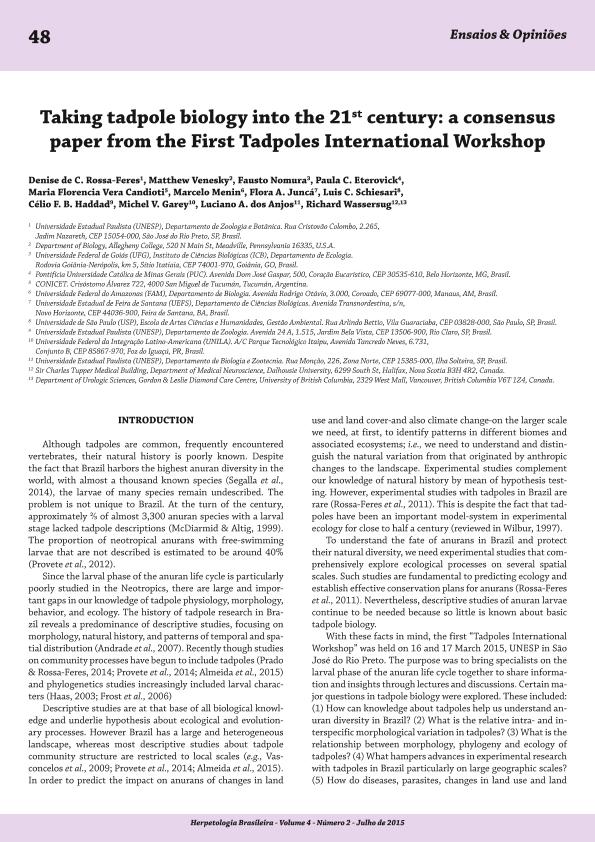Artículo
Taking tadpole biology into the 21st century: a consensus paper from the First Tadpoles International Workshop
Rossa Feres, Denise de C.; Venesky, Matthew; Nomura, Fausto; Eterovick, Paula C.; Vera Candioti, María Florencia ; Menin, Marcelo; Juncá, Flora A.; Schiesari, Luis C.; Haddad, Celio F. B.; Garey, Michel V.; dos Anjos, Luciano A.; Wasserug, Richard
; Menin, Marcelo; Juncá, Flora A.; Schiesari, Luis C.; Haddad, Celio F. B.; Garey, Michel V.; dos Anjos, Luciano A.; Wasserug, Richard
 ; Menin, Marcelo; Juncá, Flora A.; Schiesari, Luis C.; Haddad, Celio F. B.; Garey, Michel V.; dos Anjos, Luciano A.; Wasserug, Richard
; Menin, Marcelo; Juncá, Flora A.; Schiesari, Luis C.; Haddad, Celio F. B.; Garey, Michel V.; dos Anjos, Luciano A.; Wasserug, Richard
Fecha de publicación:
07/2015
Editorial:
Sociedade Brasileira de Herpetologia
Revista:
Herpetologia Brasileira
ISSN:
2316-4670
Idioma:
Inglés
Tipo de recurso:
Artículo publicado
Clasificación temática:
Resumen
Although tadpoles are common, frequently encountered vertebrates, their natural history is poorly known. Despite the fact that Brazil harbors the highest anuran diversity in the world, with almost a thousand known species (Segalla et al., 2014), the larvae of many species remain undescribed. The problem is not unique to Brazil. At the turn of the century, approximately ⅔ of almost 3,300 anuran species with a larval stage lacked tadpole descriptions (McDiarmid & Altig, 1999). The proportion of neotropical anurans with free-swimming larvae that are not described is estimated to be around 40% (Provete et al., 2012).
Palabras clave:
Tadpoles
,
Morphology
,
Ecology
Archivos asociados
Licencia
Identificadores
Colecciones
Articulos(CCT - NOA SUR)
Articulos de CTRO.CIENTIFICO TECNOL.CONICET - NOA SUR
Articulos de CTRO.CIENTIFICO TECNOL.CONICET - NOA SUR
Articulos(UEL)
Articulos de UNIDAD EJECUTORA LILLO
Articulos de UNIDAD EJECUTORA LILLO
Citación
Rossa Feres, Denise de C.; Venesky, Matthew; Nomura, Fausto; Eterovick, Paula C.; Vera Candioti, María Florencia; et al.; Taking tadpole biology into the 21st century: a consensus paper from the First Tadpoles International Workshop; Sociedade Brasileira de Herpetologia; Herpetologia Brasileira; 4; 2; 7-2015; 48-59
Compartir



